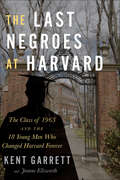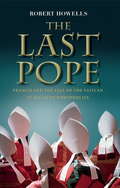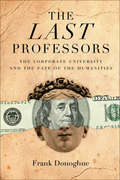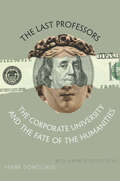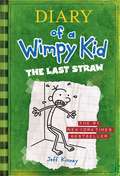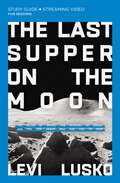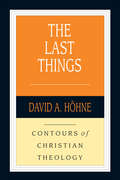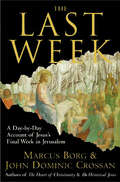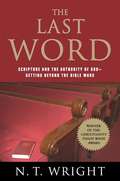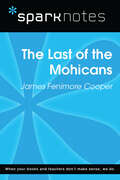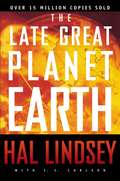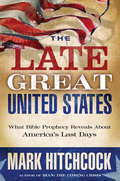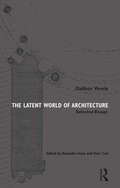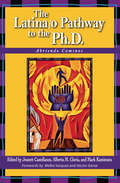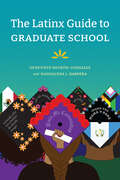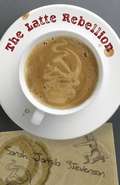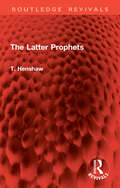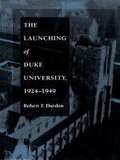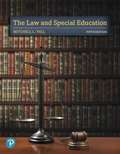- Table View
- List View
The Last Negroes At Harvard: The Class of 1963 and the 18 Young Men Who Changed Harvard Forever
by Kent Garrett Jeanne EllsworthThe untold story of Harvard’s class of ’63, whose Black students fought to craft their own identities on the cusp between integration & affirmative action.In the fall of 1959, Harvard recruited an unprecedented eighteen “Negro” boys as an early form of affirmative action. Four years later they would graduate as African Americans. Some fifty years later, one of these trailblazing Harvard grads, Kent Garrett, would begin to reconnect with his classmates and explore their vastly different backgrounds, lives, and what their time at Harvard meant.Garrett and his partner Jeanne Ellsworth recount how these eighteen youths broke new ground, with ramifications that extended far past the iconic Yard. By the time they were seniors, they would have demonstrated against national injustice and grappled with the racism of academia, had dinner with Malcolm X and fought alongside their African national classmates for the right to form a Black students’ organization.Part memoir, part group portrait, and part narrative history of the intersection between the civil rights movement and higher education, this is the remarkable story of brilliant, singular boys whose identities were changed at and by Harvard, and who, in turn, changed Harvard.
The Last Pope
by Robert HowellsNearly a thousand years ago the Archbishop of Armagh, later canonised as St Malachy, made a series of prophecies that were hidden in the Vatican for 400 years. His predictions gave clues to the identities of the 109 Popes from medieval times to present day, including the final Pope who would oversee the end of the Papacy and the fall of the Roman Catholic Church. The Last Pope examines the sudden 'rediscovery' of these prophecies in the 16th century and how they may have been used as propaganda in the campaign to promote Pope Gregory XIV to the papal throne. The book also explores the claim that the prophecies are forgeries. Ultimately, they stand or fall by their accuracy (after the time of their rediscovery), and there are many examples where, even in recent years, they have proven to be entirely correct. With Pope Benedict XVI we may have reached the penultimate Pope. According to the prophecies of St Malachy, the next Pope will be the last. In the final prophecy, St Malachy describes the last Pope as 'Peter the Roman'. By deduction, Robert Howells has identified which Cardinals are likely to be present at the next Vatican Conclave to choose a successor to Pope Benedict XVI.A favourite among them is a candidate who can readily be identified as 'Peter the Roman'. If he comes to power he may yet prove Malachy right, and oversee the fall of Rome and the destruction of the Catholic Church.
The Last Professors: The Corporate University and the Fate of the Humanities
by Frank Donoghue“What makes the modern university different from any other corporation?” asked Columbia’s Andrew Delbanco recently in the New York Times. “There is more and more reason to think: less and less,” he answered. In this provocative book, Frank Donoghue shows how this growing corporate culture of higher education threatens its most fundamental values by erasing one of its defining features: the tenured professor. Taking a clear-eyed look at American higher education over the last twenty years, Donoghue outlines a web of forces—social, political, and institutional—dismantling the professoriate. Today, fewer than 30 percent of college and university teachers are tenured or on tenure tracks, and signs point to a future where professors will disappear. Why? What will universities look like without professors? Who will teach? Why should it matter? The fate of the professor, Donoghue shows, has always been tied to that of the liberal arts —with the humanities at its core. The rise to prominence of the American university has been defined by the strength of the humanities and by the central role of the autonomous, tenured professor who can be both scholar and teacher. Yet in today’s market-driven, rank- and ratings-obsessed world of higher education, corporate logic prevails: faculties are to be managed for optimal efficiency, productivity, and competitive advantage; casual armies of adjuncts and graduate students now fill the demand for teachers. Bypassing the distractions of the culture wars and other “crises,” Donoghue sheds light on the structural changes in higher education—the rise of community colleges and for-profit universities, the frenzied pursuit of prestige everywhere, the brutally competitive realities facing new Ph.D.s —that threaten the survival of professors as we’ve known them. There are no quick fixes in The Last Professors; rather, Donoghue offers his fellow teachers and scholars an essential field guide to making their way in a world that no longer has room for their dreams.
The Last Professors: The Corporate University and the Fate of the Humanities, With a New Introduction
by Frank Donoghue“What makes the modern university different from any other corporation?” asked Columbia’s Andrew Delbanco recently in the New York Times. “There is more and more reason to think: less and less,” he answered.In this provocative book, Frank Donoghue shows how this growing corporate culture of higher education threatens its most fundamental values by erasing one of its defining features: the tenured professor.Taking a clear-eyed look at American higher education over the last twenty years, Donoghue outlines a web of forces—social, political, and institutional—dismantling the professoriate. Today, fewer than 30 percent of college and university teachers are tenured or on tenure tracks, and signs point to a future where professors will disappear. Why? What will universities look like without professors? Who will teach? Why should it matter? The fate of the professor, Donoghue shows, has always been tied to that of the liberal arts —with thehumanities at its core. The rise to prominence of the American university has been defined by the strength of the humanities and by the central role of the autonomous, tenured professor who can be both scholar and teacher. Yet in today’s market-driven, rank- and ratings-obsessed world of higher education, corporate logic prevails: faculties are to be managed for optimal efficiency, productivity, and competitive advantage; casual armies of adjuncts and graduate students now fill the demand for teachers.Bypassing the distractions of the culture wars and other “crises,” Donoghue sheds light on the structural changes in higher education—the rise of community colleges and for-profit universities, the frenzied pursuit of prestige everywhere, the brutally competitive realities facing new Ph.D.s —that threaten the survival of professors as we’ve known them. There are no quick fixes in The Last Professors; rather, Donoghue offers his fellow teachers and scholarsan essential field guide to making their way in a world that no longer has room for their dreams.First published in 2008, "The Last Professors" have largely had its arguments borne out in the interim, as the percentage of courses taught by tenured professors continues to dwindle. This new edition includes a substantial Preface that elaborates on recent developments and offers tough but productive analysis that will be crucial for today's academics to heed.
The Last Safe Investment
by Michael Ellsberg Bryan FranklinThe case for investing in your own career before anything elseMichael Ellsberg and Bryan Franklin think you've been fed a lie: that if you save for decades and invest in 401(k)s, IRAs, and a home, these investments will grow steadily over decades, allowing twenty to thirty years of secure, peaceful retirement.This might have been true at some point in the last century, but it is not true any longer. If you want to get ahead and enjoy a life of prosperity, the authors argue that you must invest in the most powerful source of wealth you'll ever know: your own earning power.Ellsberg and Franklin reveal how investing in yourself in various ways can guarantee a return much higher than the stock market or real estate. Boosting your skills, leadership, persuasion ability, and your network enriches the quality and meaning of your life at the same time that it enriches your wallet. Why wouldn't you bet on yourself?
The Last Straw (Diary of a Wimpy Kid #3)
by Jeff KinneyMiddle-schooler Greg Heffley nimbly sidesteps his father's attempts to change Greg's wimpy ways until his father threatens to send him to military school.
The Last Straw (Diary of a Wimpy Kid #3)
by Jeff KinneyMiddle-schooler Greg Heffley nimbly sidesteps his father's attempts to change Greg's wimpy ways until his father threatens to send him to military school.
The Last Supper on the Moon Bible Study Guide plus Streaming Video: The Ocean of Space, the Mystery of Grace, and the Life Jesus Died for You to Have
by Levi LuskoThis Study Guide includes:Individual access to five streaming video sessionsDiscussion and reflection questions with video notesPersonal study between sessionsLeader&’s GuideIn the summer of 1969, Buzz Aldrin had a mission. His goal was to fly 240 million miles from earth and, along with fellow astronaut Neil Armstrong, be the first to walk on the moon. But moments before that historic step, Aldrin poured a specially prepared drink into a cup and partook of a sacred celebration that had first occurred two thousand years before. The lunar Last Supper was full of meaning, just as it had been when Jesus himself took of the elements and acknowledged his calling and purpose. But the significance didn't end there. Today, as we remember the sacrifice of Christ on the cross, followed by his resurrection, we are reminded that what seemed to be an end became the genesis of everything—including the rescue and restoration of anyone who calls on Jesus' name. In this five-session study, bestselling author and pastor Levi Lusko journeys back in time and forward in hope, using the 1969 lunar mission as an analogy of the metamorphosis that was unleashed by the man from Galilee. Along the way, he uncovers the remarkable "seven statements" that Jesus made from the cross—words that provide us everything we need in the chaos of our world to conquer judgment, persecution, anxiety, and pain.Designed for use with The Last Supper on the Moon Video Study (sold separately).Streaming video access code included. Access code subject to expiration after 12/31/2027. Code may be redeemed only by the recipient of this package. Code may not be transferred or sold separately from this package. Internet connection required. Void where prohibited, taxed, or restricted by law. Additional offer details inside.
The Last Supper on the Moon: NASA's 1969 Lunar Voyage, Jesus Christ’s Bloody Death, and the Fantastic Quest to Conquer Inner Space
by Levi LuskoIf there are places in your heart and corners of your mind that feel just as deep and dark and inaccessible as outer space, this book is for you. Fight as you may, unearthing the happiness and fulfillment you long for can feel nearly impossible. In Psalm 8 David urges us to consider the heavens, to look up at the night sky. Doing so will help you discover fundamental truths about God. Namely, that—even though his love for you is as beyond comprehension as the farthest corners of the universe—through his Son, you can grab hold of it, and it has the power to transform your inner space.Bestselling author Levi Lusko shares how you can:learn that life is not about &“finding yourself&” but discovering who Jesus isbelieve that God&’s love and forgiveness is grander than even your greatest failure buck the mundane of everyday life and start dreaming againEmbark on an adventure tracing the words and wonders of Jesus on his trek to the cross. Let The Last Supper on the Moon compel you to live with a more profound sense of purpose and a grander view of Jesus, and set you on a trajectory to life, and life more abundantly.
The Last Things (Contours of Christian Theology)
by David HöhneThere is no shortage of books on eschatology—the study of the last things and the end-times. Many arise out of incoherent or superficial readings of the Bible that detract from the "once and for all" achievements of God through the death and resurrection of the Lord Jesus. Others fail to consider the manner in which God reveals himself through the Lord Jesus and by the power of his Spirit. Too many fail to distinguish sufficiently between the genuine hope provided by the gospel and the superficial aspirations of culture. In this final Contours of Christian Theology volume, David Höhne offers a trinitarian theological description of eschatology that is at once systematic, generated from the theological interpretation of Scripture, and yet sensitive to essential elements for Christian practice. His reading of the Bible is shaped by the gospel, informed by the history of Christian thought, and dedicated to serving the church in a world that is frustrated by sin, death, and evil, yet longing for the return of our Lord and Messiah. Contours of Christian Theology, edited by Gerald Bray, is a series of concise introductory textbooks focused on the main themes of Christian theology. The authors introduce the perennial questions and their time-tested solutions while moving forward to explore contemporary issues and rework evangelical formulations of the faith.
The Last Week: What the Gospels Really Teach About Jesus's Final Days in Jerusalem
by John Dominic Crossan Marcus J. BorgTop Jesus scholars Marcus J. Borg and John Dominic Crossan join together to reveal a radical and little-known Jesus. As both authors reacted to and responded to questions about Mel Gibson's blockbuster The Passion of the Christ, they discovered that many Christians are unclear on the details of events during the week leading up to Jesus's crucifixion. Using the gospel of Mark as their guide, Borg and Crossan present a day-by-day account of Jesus's final week of life. They begin their story on Palm Sunday with two triumphal entries into Jerusalem. The first entry, that of Roman governor Pontius Pilate leading Roman soldiers into the city, symbolized military strength. The second heralded a new kind of moral hero who was praised by the people as he rode in on a humble donkey. The Jesus introduced by Borg and Crossan is this new moral hero, a more dangerous Jesus than the one enshrined in the church's traditional teachings. The Last Week depicts Jesus giving up his life to protest power without justice and to condemn the rich who lack concern for the poor. In this vein, at the end of the week Jesus marches up Calvary, offering himself as a model for others to do the same when they are confronted by similar issues. Informed, challenged, and inspired, we not only meet the historical Jesus, but meet a new Jesus who engages us and invites us to follow him.
The Last Word
by N. T. WrightWhile showing how both evangelicals and liberals misread Scripture, a leading Bible scholar and Anglican bishop shows how to restore the Bible's authority today for guiding the church through its many controversies.
The Last of the Mohicans (SparkNotes Literature Guide Series)
by SparkNotesThe Last of the Mohicans (SparkNotes Literature Guide) by James Fenimore Cooper Making the reading experience fun! Created by Harvard students for students everywhere, SparkNotes is a new breed of study guide: smarter, better, faster. Geared to what today's students need to know, SparkNotes provides: *Chapter-by-chapter analysis *Explanations of key themes, motifs, and symbols *A review quiz and essay topicsLively and accessible, these guides are perfect for late-night studying and writing papers
The Late Great Planet Earth
by Hal Lindsey C. C. CarlsonA look at what biblical prophecy tells us about our times, the future, and the return of Jesus Christ.
The Late Great Planet Earth
by Hal Lindsey Carole C. CarlsonThe impact of The Late Great Planet Earth cannot be overstated. The New York Times called it the "no. 1 non-fiction bestseller of the decade." For Christians and non-Christians of the 1970s, Hal Lindsey's blockbuster served as a wake-up call on events soon to come and events already unfolding -- all leading up to the greatest event of all: the return of Jesus Christ. The years since have confirmed Lindsey's insights into what biblical prophecy says about the times we live in. Whether you're a church-going believer or someone who wouldn't darken the door of a Christian institution, the Bible has much to tell you about the imminent future of this planet. In the midst of an out-of-control generation, it reveals a grand design that's unfolding exactly according to plan. The rebirth of Israel. The threat of war in the Middle East. An increase in natural catastrophes. The revival of Satanism and witchcraft. These and other signs, foreseen by prophets from Moses to Jesus, portend the coming of an antichrist . . . of a war which will bring humanity to the brink of destruction . . . and of incredible deliverance for a desperate, dying planet.
The Late United States: What Bible Prophecy Reveals About America's Last Days
by Mark HitchcockIs it possible the United States, a superpower without peer in history, might not be a key player as the world makes its way down the road to the Battle of Armageddon? This is the central question explored by prophecy expert Mark Hitchcock inThe Late Great United States,a fascinating behind-the-headlines look at numerous current events and how they relate to what the Bible says about the last days. Americans are accustomed to seeing their country center stage as a world power, but as Hitchcock carefully details, this may not be the case inthefinal scene. Based on extensive research of the Bible and other sources,The Late Great United Statesprovides compelling and often surprising answers to questions like these: •Does the Bible say anything about America in the last days? •How could the U. S. fit into God’s prophetic plan? •Will America survive? •Might the anti-Christ come from America? •Could America’s addiction to oil be her undoing? •Will America be destroyed by a nuclear attack? •Could America fall from within as a result of moral corruption? •Is America still a “blessed” nation? •How should individual Christians respond to a world in chaos? Regardless of America's final fate and the outcome of dire events at the end of the age, Hitchcock urges us to find our hope in a God who will not forsake us–no matter what cataclysms we experience on earth. From the Hardcover edition.
The Latent World of Architecture: Selected Essays
by Dalibor VeselyThis book features thirteen essays by the late architect, philosopher and teacher Dalibor Vesely (1934–2015). Vesely was a leading authority on philosophical hermeneutics and phenomenology in relation to architecture worldwide, and influenced a generation of thinkers, teachers and practitioners. This collection presents the full range of his writing, drawing primarily from the history of art and architecture, as well as philosophy, theology, anthropology and ecology, and spanning from early antiquity to modernism. It composes a multifaceted and globally relevant argument about the enduring cultural role of architecture and the significance of its history. The book, edited and introduced by Vesely’s teaching partner at Cambridge Peter Carl and former student Alexandra Stara, and with a foreword by David Leatherbarrow, brings to light new and hard-to-access material for those familiar with Vesely’s thought and, at the same time, offers a compelling introduction to his writing and its profound relevance for architecture and culture today.
The Latest Illustrated Book of Development Definitions
by Carl G. LindbloomIllustrated definitions are rarely found in zoning and development ordinances. Ordinances prefer the "thousand words" rather than the "single picture." Illustrations greatly simplify how standards should be applied, particularly where the lot or parcel is irregularly shaped or where there are a number of variables present, each of which might have an impact on how the ordinance might apply in a specific situation. This best-selling resource has been the mainstay of the planner's bookshelf since its first publication and it differs from other books and publications containing development definitions in three major respects: It is illustrated; most of the definitions are designed to be used directly in ordinances with little or no change; and the more complex definitions are accompanied by commentaries and annotations that explain how the definition may be used in an ordinance, along with background information pertinent to the definition. This expanded edition standardizes in one handy reference all the key terms used in zoning, subdivision, site plan, and environmental ordinances. In all, it contains 1,957 definitions and 103 illustrations that can be incorporated in local ordinances with little or no change. Written and illustrated by two professional planners with nearly eighty years of combined experience in the practice of planning and zoning, this is a basic working tool and required reference for anyone involved in land development planning and regulation.
The Latina/o Pathway to the Ph.D.: Abriendo Caminos
by Jeanett Castellanos Alberta M. Gloria Mark KamimuraThe Latina/o population constitutes the largest racial and ethnic minority group in the U.S. and is disproportionately under-represented in college and in graduate programs. This is the first book specifically to engage with the absence of Latinas/os in doctoral studies. It proposes educational and administrative strategies to open up the pipeline, and institutional practices to ensure access, support, models and training for Latinas/os aspiring to the Ph.D. The under-education of Latina/o youth begins early. Given that by twelfth grade half will stop out or be pushed out of high school, and only seven percent will complete a college degree, it is not surprising so few enter graduate studies. When Latina/o students do enter higher education, few attend those colleges or universities that are gateways to graduate degrees. Regardless of the type of higher education institution they attend, Latinas/os often encounter social and academic isolation, unaffordable costs, and lack of support.This historic under-representation has created a vicious cycle of limited social and economic mobility. There is a paucity of the Latina/o faculty and leaders whom research shows are essential for changing campus climate and influencing institutions to adapt to the needs of a changing student body. As a result, Latina/o graduate students often have few role models, advocates or mentors, and limited support for their research agendas.By reviewing the pipeline from kindergarten through university, this book provides the needed data and insights to effect change for policy makers, administrators, faculty, and staff; and material for reflection for aspiring Latina/o Ph.D.s on the paths they have taken and the road ahead.The book then addresses the unique experiences and challenges faced by Latina/os in doctoral programs, and offers guidance for students and those responsible for them. Chapters cover issues of gender and generational differences, the role of culture in the graduate school, mentorship, pursuing research, and professional development opportunities for Latina/os.The book closes with the voices of by Latina/o students who are currently pursuing or recently completed their doctoral degree. These narratives describe their cultural and educational journeys, providing insight into their personal and professional experiences. These stories bring alive the graduate experience for anyone interested in successful recruitment, retention, and graduation of Latina/o doctoral students – an inspiration and guidance to those aspiring to the doctorate.
The Latinx Guide to Graduate School
by Genevieve Negrón-Gonzales Magdalena L. BarreraIn The Latinx Guide to Graduate School Genevieve Negrón-Gonzales and Magdalena L. Barrera provide prospective and current Latinx graduate students in the humanities and social sciences fields with a roadmap for surviving and thriving in advanced-degree programs. They document the unwritten rules of graduate education that impact Latinx students, demystifying and clarifying the essential requirements for navigating graduate school that Latinx students may not know because they are often the first in their families to walk that path. Topics range from identifying the purpose of graduate research, finding the right program, and putting together a strong application to developing a graduate student identity, cultivating professional and personal relationships, and mapping out a post--graduate school career. The book also includes resources for undocumented students. Equal parts how-to guide, personal reflection, manifesto, and academic musing, this book gives a culturally resonant perspective that speaks to the unique Latinx graduate student experience.
The Latte Rebellion
by Sarah Jamila StevensonWhen high school senior Asha is called a "towel head" at a pool party, she and her best friend Carey start a club to raise awareness of mixed-race students which puts her Ivy League dreams, friendship, and beliefs to the test.
The Latter Prophets (Routledge Revivals)
by T. HenshawOriginally published in 1958, this book gives a concise account of the canonical prophets, viewed in the light of modern scholarship. After introductory chapters on the prophetic literature, the historical background and the latest archaeological discoveries of the prophetic period, the rise of prophecy and the forms and characteristics of Hebrew poetry the book deals in detail with the canonical prophets themselves, giving a sketch of the life and work of each, delineating their character, and estimating their influence on the development of religion. They are revealed as outstanding personalities, forming a most remarkable group of religious teachers. The book will be of interest not only to theological students, but also to the clergy and teachers.
The Launching of Duke University, 1924–1949
by Robert F. DurdenIn this rich and authoritative history, distinguished historian Robert F. Durden tells the story of the formation of Duke University, beginning with its creation in 1924 as a new institution organized around Trinity College. As Durden reveals, this narrative belongs first and foremost to Duke University's original President, William Preston Few, whose visionary leadership successfully launched the building of the first voluntarily supported research university in the South. In focusing on Duke University's most formative and critical years--its first quarter century--Durden commemorates Few's remarkable successes while recognizing the painful realities and uncertainties of a young institution.Made possible by a gift from James B. Duke, the wealthiest member of the family that had underwritten Trinity College since 1890, Duke University was organized with Few as president. Few's goal was to turn Duke into a world-class institution of higher education and these early years saw the development of much of what we know as Duke University today. Drawing on extensive archival material culled over a ten-year period, Durden discusses the building of the Medical Center, the rebuilding of the School of Law, the acquisition of the Duke Forest and development of the School of Forestry, the nurturing of the Divinity School, and the enrichment of the Graduate School of Arts and Sciences.It was also during this period, as Durden details, that such treasures as the Sarah P. Duke Gardens were created, as well as some near treasures, as seen by the failed attempt to start an art museum. Although the story of the birth of this University belongs largely to William Preston Few, other people figure prominently and are discussed at length. Alice Baldwin, who led in the establishment of the Woman's College, emerges as a fascinating figure, as do William H. Wannamaker, James B. Duke, William Hanes Ackland, Robert L. Flowers, Justin Miller, and Wilburt Cornell Davision, among others.Although impressive growth occurred in Duke's formative years, tensions also arose. The need to strike an institutional balance between the twin demands of teaching and research, of regional versus national status, combined with continual shortages of funds, created occasional obstacles. The problem of two sets of trustees, one for the university and another for the Duke Endowment, loomed largest of all. As Few himself said, during these early years Duke successfully embarked on a long journey, for it was not until after World War II that Duke University consolidated the growth begun in the inter-war years. An important contribution to the history of Southern higher education as well as to Duke University, this book will be of great interest to historians, alumni, and friends of Duke University alike.
The Law And Special Education
by Mitchell YellHelp educators understand the historical and current legal issues in special education The Law and Special Education helps teachers and educational administrators understand their legal obligations relative to providing a free, appropriate public education for students with disabilities. Clear, straightforward, and very accessible, this indispensable resource (1) walks readers through the history and current developments of special education law and (2) gives educators the information and the tools they need to develop legally sound and educationally appropriate special education programs. <p><p> The 5th Edition is updated to keep readers informed of the latest developments and refinements in special education law, including: the Supreme Court rulings in the Endrew F. v. Douglas County Schools and Fry v. Napoleon Community Schools cases; new U.S. Department of Education policy letters and cases; updated coverage of the Every Student Succeeds Act of 2015; new coverage of charter schools and students with disabilities; IEP implementation cases; and a new section on standards-based IEP.
The Law Of Disability Discrimination For Higher Educational Professionals
by Ruth Colker Paul GrossmanThe purpose of The Law of Disability Discrimination for Higher Education Professionals is to provide an in-depth understanding of the ADA and related statutes to the many individuals who are responsible for disability equality in higher education: disabled student services directors, ADA officers, house and contract counsel, human resource directors, college grievances officers, ombudspersons, federal and state compliance agents, organizational advocates, health and counseling service personnel, deans and faculty, etc.
